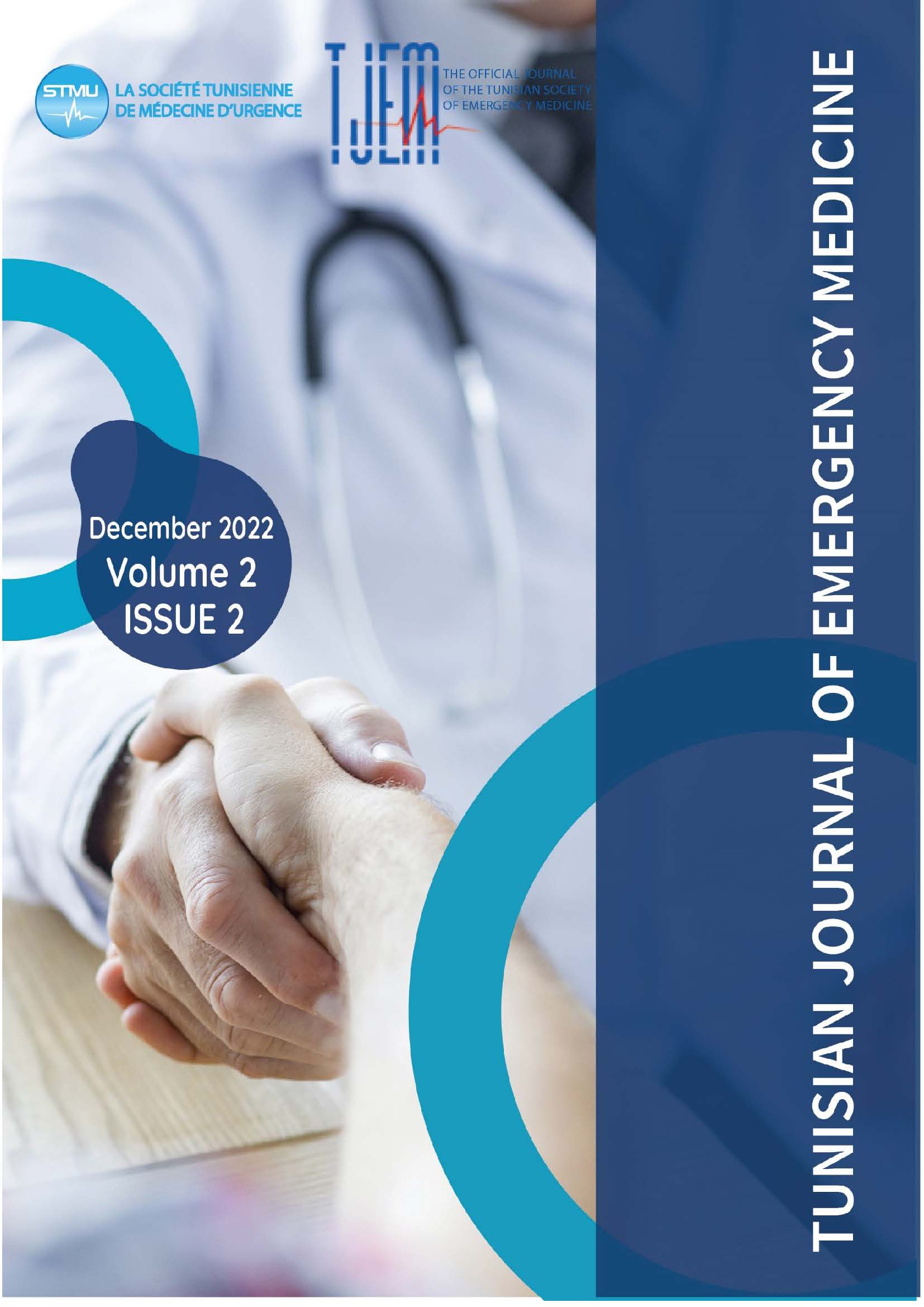Prognostic factors of assault-induced stab wounds in the emergency department
Safia OTHMANI, Sarra JOUINI, Asma MELLOULI, Houyem ZOUARI, Mouna JEMAI, Hana HEDHLI
DOI:
https://doi.org/10.0000/qabsd008Keywords:
Trauma, Stab wounds, Blood pressure, Respiratory rate, prognosisAbstract
Background: Stab wounds (SWs) represent one of the major components of trauma, especially in the emergency department (ED), and can have dreadful outcomes.
Aim: Our study aimed to assess the different epidemiological, clinical, and therapeutic features of SWs in the ED as well as prognostic factors determining short-term evolution (STE).
Method: A descriptive, cross-sectional single-center study was conducted in a polyvalent ED room of the Charles Nicolle hospital of Tunis, including patients presenting for assault-induced over ten months.
Unfavorable STE was defined by: oxygen therapy needs, fluid expansion, catecholamine and/or tranexamic acid use, transfusion, thoracic drainage, intubation, and urgent surgery.
The statistical analysis concerned the study population (SP) subgroups who have penetrating stab wounds (PSWs) or superficial stab wounds (SSWs). The risk factors search of STE was carried out by a univariate analysis, binary logistic regression with Receiver Operating Characteristics curves (ROC) analysis.
Results: We included 130 patients, with male predominance and a sex ratio of 15. The median age was 30. The majority (90.8%) had no pathological medical history. Forty percent of the injuries were located on the torso (n=52). Initial clinical assessment showed that most of the patients were hemodynamically stable Four patients (3.1%) had systolic blood pr tients (6.2%) a mean arterial blood pressure (MAP) <65mmHg. Seven patients (5.4%) were hypoxemic. Univariate analysis showed that respiratory rate (RR), and blood pressure (BP) were significantly associated with unfavorable STE. Receiving operating curve (ROC) analysis concluded a high discriminating ability for RR and BP. Logistic regression analysis showed that RR>19cpm and SBP <105 mmHg are independent risk factors with respective AORs of 8.64 and 14.29 IC.
Conclusion: Unfavorable STE can be predicted through clinical parameters such as RR>19cpm and/or SBP<105 mmHg in PSW's victims.
Downloads
Published
Issue
Section
License
Copyright (c) 2022 Tunisian Journal of Emergency Medicine

This work is licensed under a Creative Commons Attribution-NonCommercial-ShareAlike 4.0 International License.
How to Cite
Similar Articles
- Wiem Feki, Fatma Hammami, Amina Kammoun, Makram Koubaa, Zaineb Mnif, Vascular causes of pediatric acute ischemic stroke: the crucial role of imaging , Tunisian Journal of Emergency Medicine: Vol. 3 No. 2 (2025): TJEM 2025: Vol.3 Issue 2
- Mounir NAIJA, Rabeb Mbarek, Sondes Laajimi, Haifa BRADAÏ, Dorra Loghmari, A Wandering Atrial Pacemaker in Inferior Wall Infarction. Escape or Survival Rhythm? A Case Report , Tunisian Journal of Emergency Medicine: Vol. 3 No. 2 (2025): TJEM 2025: Vol.3 Issue 2
- Wiem Feki, Fatma Hammami, Amina Kammoun, Makram Koubaa, Mounir Ben Jemaa, Zaineb Mnif, Emphysematous pyelonephritis with infected abdominal aorta pseudoaneurysm among a diabetic man , Tunisian Journal of Emergency Medicine: Vol. 3 No. 2 (2025): TJEM 2025: Vol.3 Issue 2
- Randa dhaoui, Khaoula bel Haj Ali, Adel Sekma, Sarra Sassi , Wahid Bouida, semir nouira, The challenge in diagnosing human rabies: A case report , Tunisian Journal of Emergency Medicine: Vol. 3 No. 1 (2025): TJEM 2025: Vol.3 Issue 1
- Samia Meherzi, Rihab Omri, Amin khbou , Rabiaa Kaddechi , Afifa CHARFI, Management of Bell palsy: our clinical practice guideline , Tunisian Journal of Emergency Medicine: Vol. 3 No. 1 (2025): TJEM 2025: Vol.3 Issue 1
- Rabeb Mbarek, Khouloud Hamdi, Sarra Soua, Hela Abroug, Sondes laajimi, haifa Bradai, Dorra Loghmari , Asma SRIHA, Semir Nouira, Prehospital Particularities of Covid-19 infection and factors associated with its severity during the omicron variant wave (East-center of Tunisia) , Tunisian Journal of Emergency Medicine: Vol. 2 No. 4 (2024): TJEM Vol2 Issue4
- Dr.Rania AMMAR ZAYANI, Dr.Sarra Temani, Dr. Mabrouk Bahloul, Dr.Chokri Ben Hamida, Pregabalin Toxicity-Induced Posterior Reversible Encephalopathy Syndrome , Tunisian Journal of Emergency Medicine: Vol. 3 No. 2 (2025): TJEM 2025: Vol.3 Issue 2
- Haifa BRADAÏ, Rabeb Mbarek, Sondes Laajimi, Dorra Loghmari, Mounir NAIJA, Atrial flutter mimicking ST-elevation myocardial infarction: A case report , Tunisian Journal of Emergency Medicine: Vol. 3 No. 1 (2025): TJEM 2025: Vol.3 Issue 1
- Mounir Hagui, Sonia Slimi, Riadh Allani, Civil-Military Collaboration for health emergency preparedness , Tunisian Journal of Emergency Medicine: Vol. 2 No. 4 (2024): TJEM Vol2 Issue4
- R. Obame, Serious abdominal traumatic emergencies in the emergency department of a “Trauma Center” hospital of Libreville (Gabon): Epidemiological, diagnosis and outcomes aspects , Tunisian Journal of Emergency Medicine: Vol. 2 No. 3 (2023): TJEM Vol2 Issue3
You may also start an advanced similarity search for this article.
Most read articles by the same author(s)
- safia othmani, Ischemic acute cholecystitis: a case report , Tunisian Journal of Emergency Medicine: Vol. 2 No. 4 (2024): TJEM Vol2 Issue4

